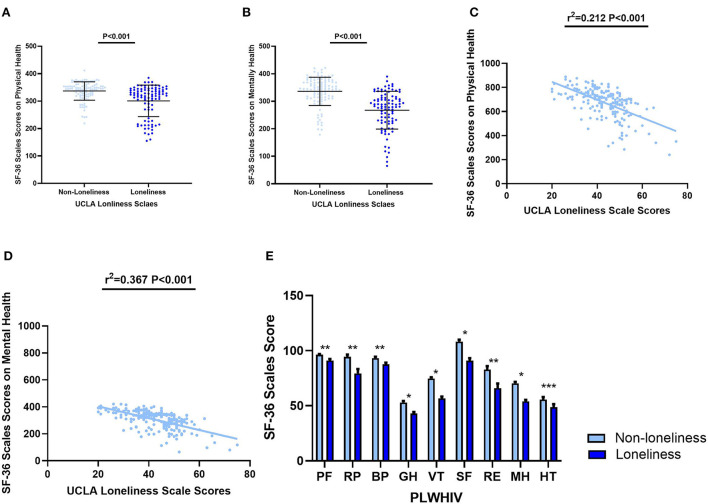Figure 3.
Aspects of HRQoL in the loneliness and non–loneliness groups. (A) The SF−36 Scale score on physical health of PLWHIV with loneliness were 336.85 ± 33.52, significantly higher than that without loneliness 300.70 ± 57.36 (P < 0.001). (B) The SF−36 Scale score on mental health of PLWHIV with loneliness were 335.95 ± 51.38, significantly higher than that without loneliness 267.44 ± 68.69 (P < 0.001). (C) The SF−36 Scale score on physical health was significantly and negatively co–related with UCLA Loneliness Scale scores. (D) The SF−36 Scale score on mental health was significantly and negatively co–related with UCLA Loneliness Scale scores. (E) Eight aspects of SF−36 Scale scores in two groups. *P < 0.001; **P < 0.05; ***P > 0.05. Non–loneliness group vs. non–loneliness group: Mean ± SD. PF: 96.31 ± 6.67 vs. 90.96 ± 14.26; RP: 94.39 ± 20.98 vs. 79.26 ± 39.93; BP: 93.23 ± 11.95 vs. 87.52 ± 11.31; GH: 52.91 ± 14.64 vs. 42.96 ± 12.97; VT: 74.63 ± 12.32 vs. 56.70 ± 15.96; SF: 108.18 ± 18.34 vs. 90.82 ± 22.98; RE: 82.87 ± 31.51 vs. 65.96 ± 41.47; MH: 70.28 ± 14.90 vs. 53.96 ± 13.72; HT: 55.53 ± 25.11 vs. 48.67 ± 27.28. SF−36, 36–Item Short Form Survey Instrument; UCLA, The University of California, Los Angeles; PF, Physical Function; RP, Role Physical; BP, Bodily Pain; GH, General Health; VT, Vitality; SF, Social Functioning; RE, Role Emotional; MH, Mental Health; HT, Reported Health Transition.

